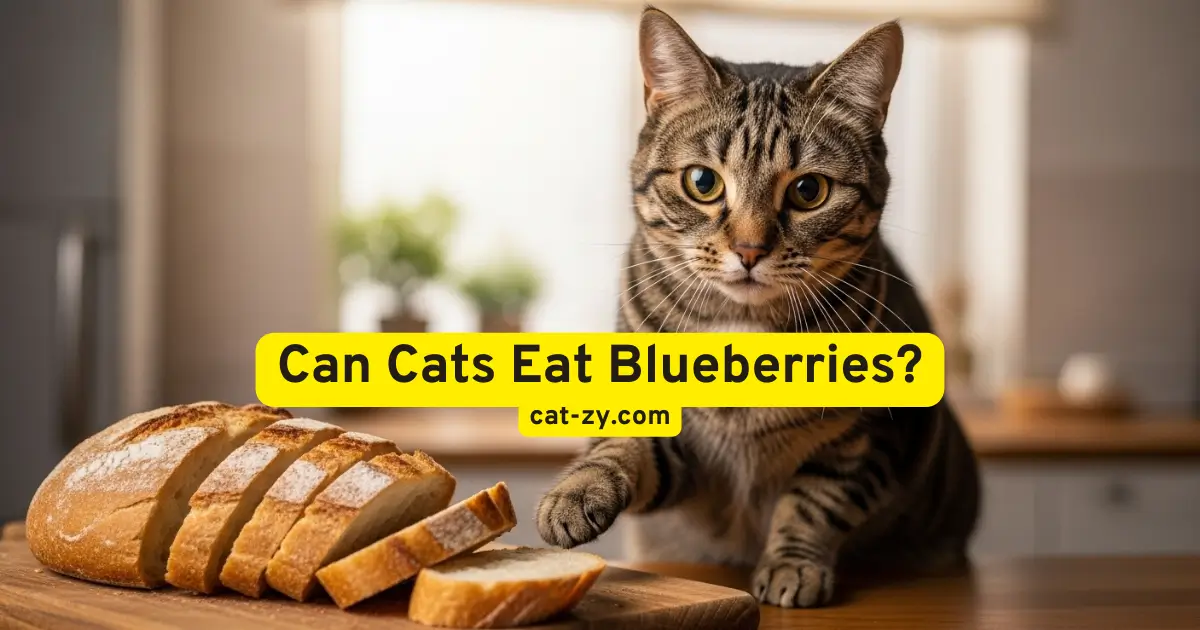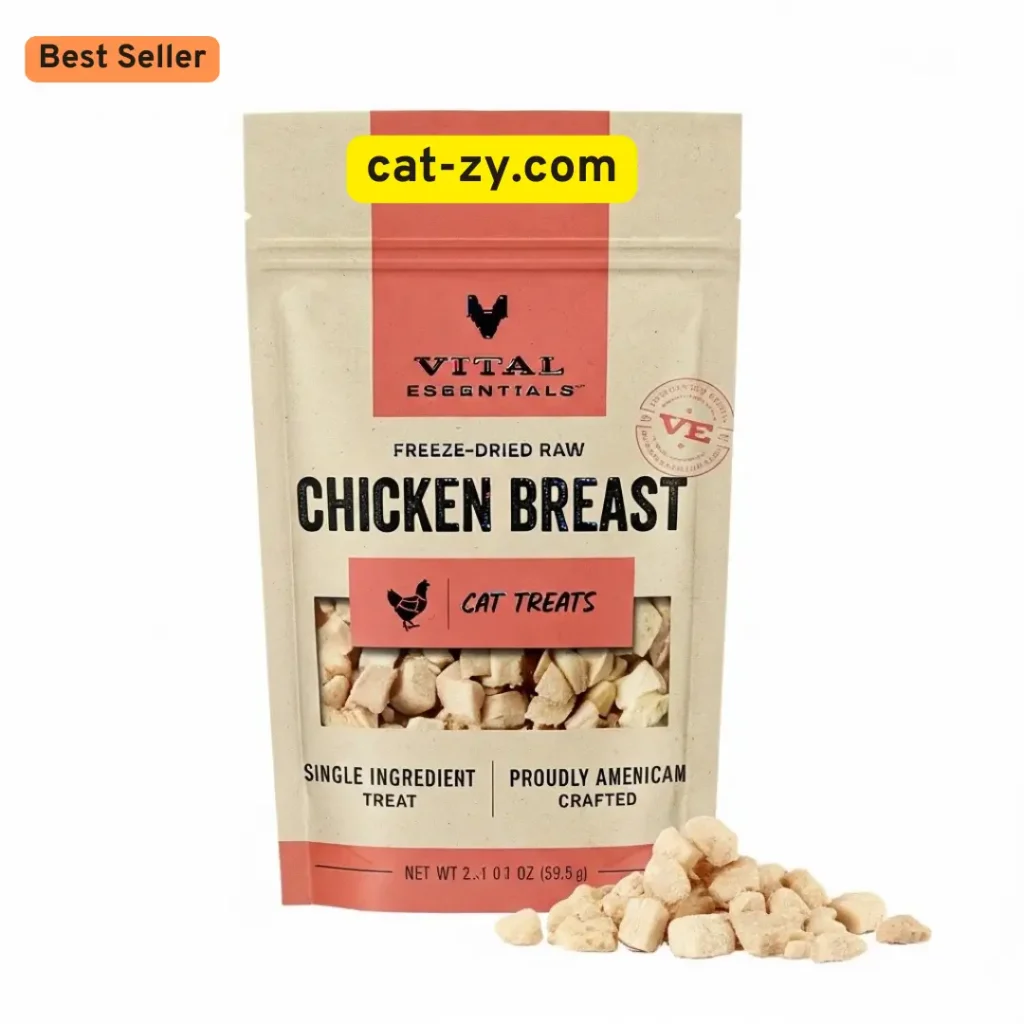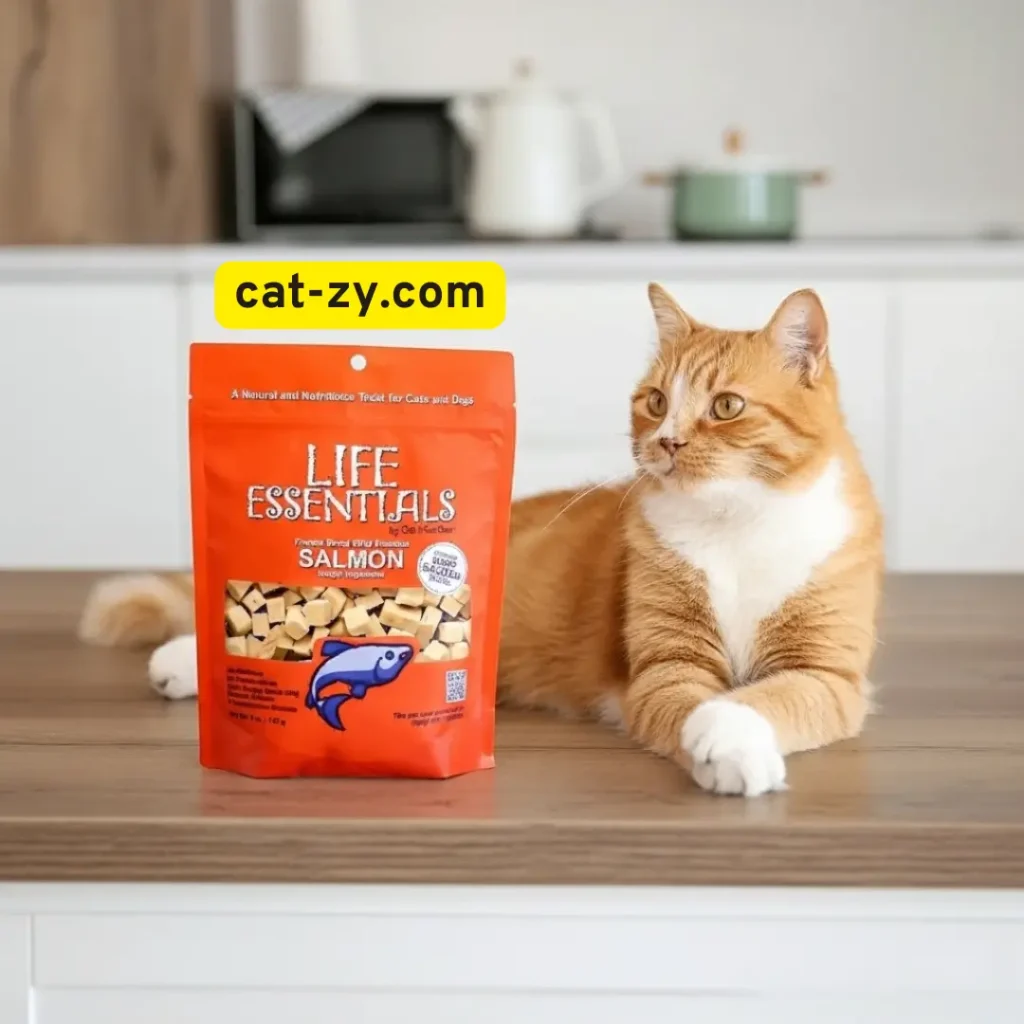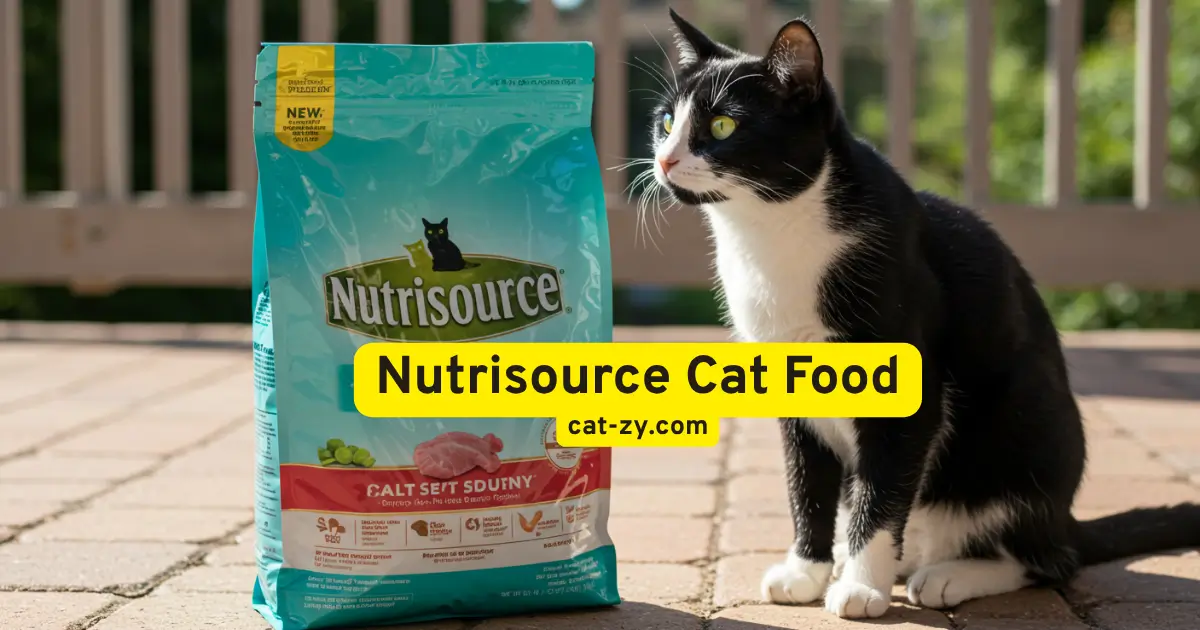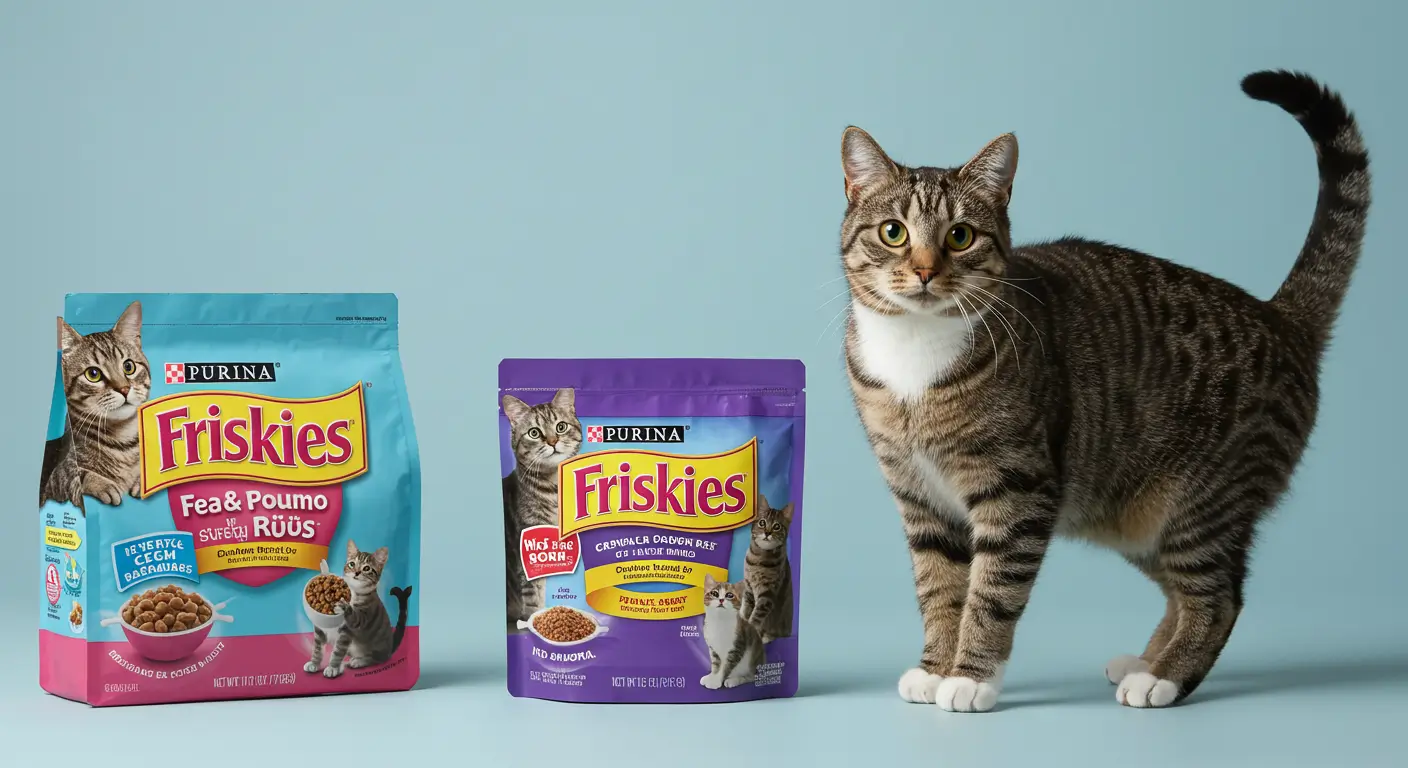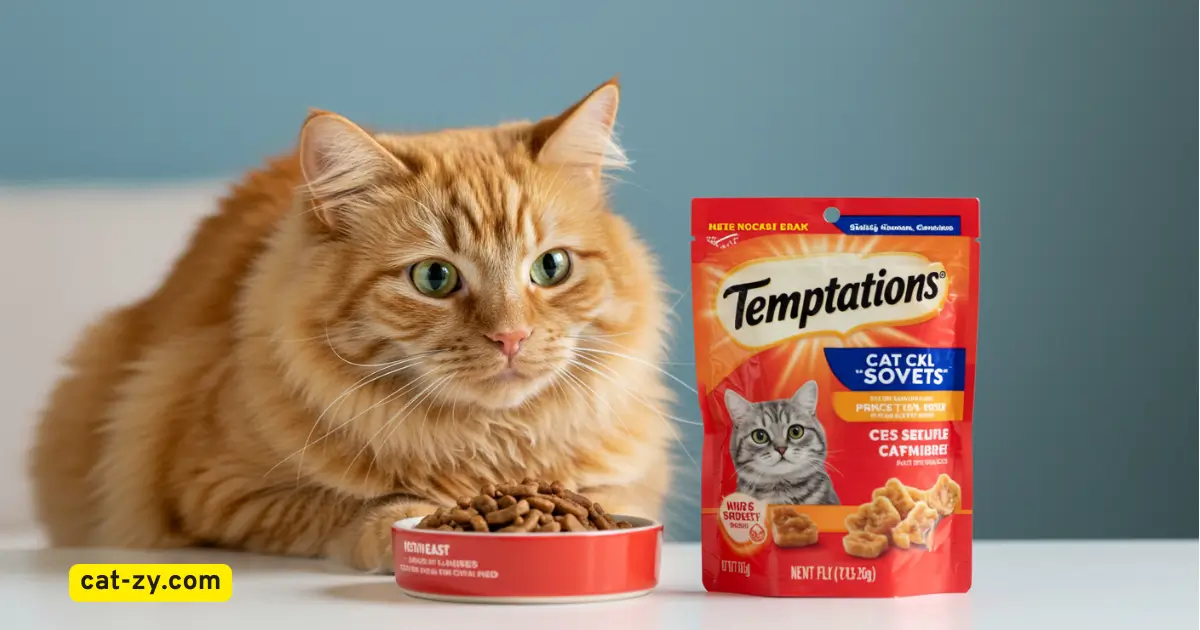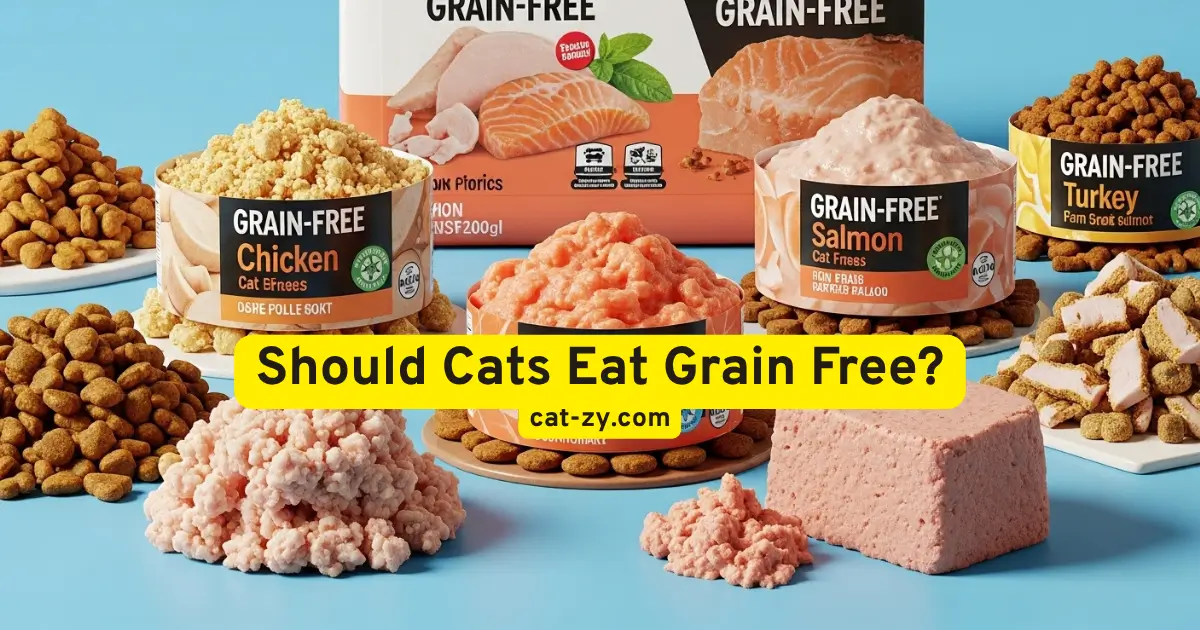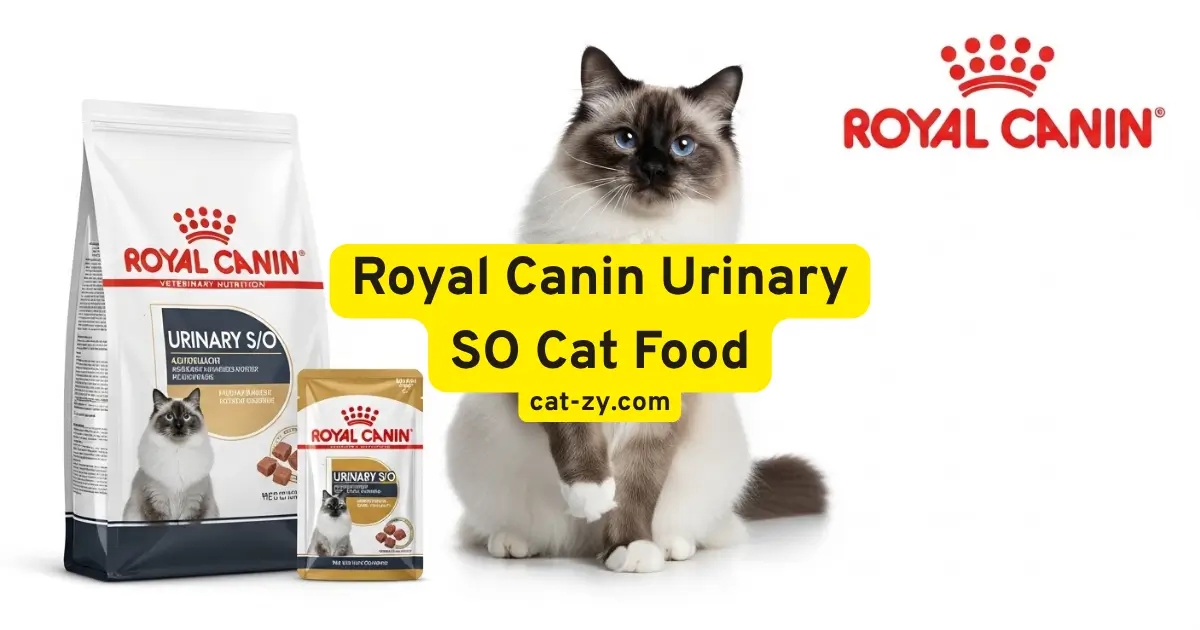Can Cats Eat Bread? 5 Shocking Facts You Must Know
As a cat owner, you might wonder ‘Can cats eat bread‘ and what treats are safe for your pet. You might have even given your cat a piece of bread. But is that a good idea? Feeding your cat bread can lead to unexpected problems.
Many of us treat our cats like family, sharing our meals with them. However, many human foods can be harmful to cats. So, should you give your cat bread? Let’s look at the surprising facts you need to know before deciding.
It’s important to know what’s safe for your cat to eat. This is key to their health and happiness. In this article, we’ll explore whether cats can have bread and what you need to do to keep them safe.
Table of Contents
The Truth About Cats and Bread
Before asking Can cats eat bread, remember that bread is a big part of our diet, but it’s not good for cats. They have special needs that are different from ours. Knowing these differences is key to keeping them healthy.
Cats’ Natural Diet vs. Human Foods
Cats are meat-eaters by nature. Their diet should mainly be meat. This is because of their evolution and body design.
Obligate Carnivores: What This Means
Being an obligate carnivore means cats need lots of protein from meat. Their bodies are made to digest meat well. They need animal products for their nutrition.
How Cats Digest Different Foods
Cats can only digest proteins and fats from meat well. Foods like bread, which are full of carbs, are hard for them. This can cause nutritional problems.
Why Cats Might Be Attracted to Bread
Even though the answer to can cats eat bread is complex, some might want it. There are a few reasons for this.
Behavioral Factors
Cats might want bread because it gets them attention. They see it as a way to connect with their owners.
Sensory Attraction
The smell and feel of bread can also draw cats in. Fresh bread smells really good to them.
Understanding why cats like bread when considering ‘can cats eat bread’ involves their curiosity and the appeal of bread’s smell and feel. But remember, feeding cats bread is not good for them. While a little bit is okay, eating it often can harm their health.
Can Cats Eat Bread? The Definitive Answer
As a cat owner, you might wonder if you can share bread with your pet. The answer isn’t just yes or no. It depends on the bread type and your cat’s health.
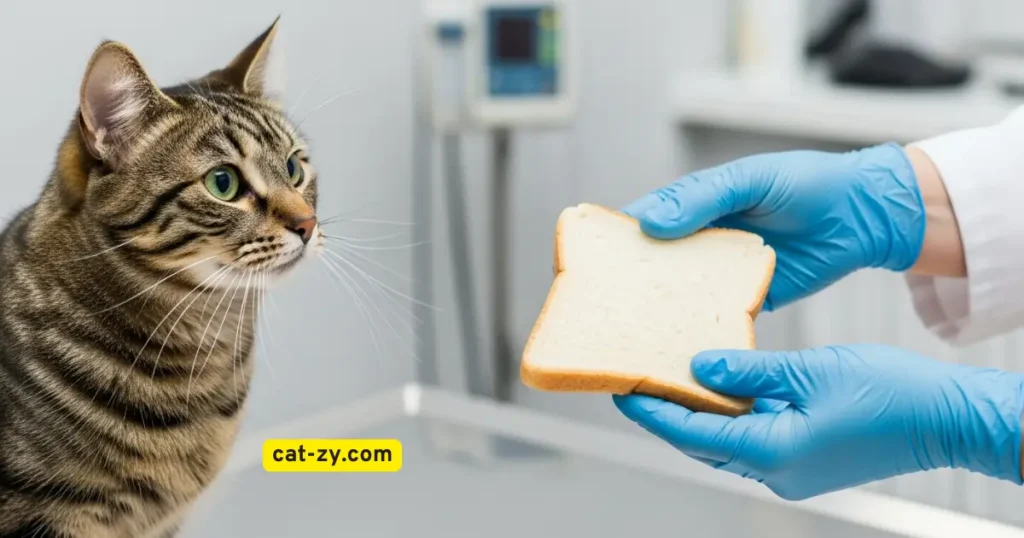
Is Bread Toxic to Cats?
The safety of bread for cats depends on its ingredients. Plain bread is usually okay, but some ingredients can be bad.
Plain Bread Safety
Basic bread poses no immediate danger to cats when given in limited quantities. But remember, it doesn’t give them any nutrients.
Dangerous Bread Ingredients
Some breads have ingredients that are bad for cats. For example, garlic and onions can harm their blood cells. Also, raisins and currants can cause kidney problems.
Nutritional Value of Bread for Cats
Bread is mostly carbs, which cats don’t need. Cats need protein from animal sources.
Carbohydrates in a Cat’s Diet
Cats can handle some carbs, but not too much. Too many carbs can make them gain weight and get sick.
Missing Essential Nutrients
Bread doesn’t have the nutrients cats need. It lacks protein, vitamins, and minerals. Eating bread regularly can make cats malnourished.
In short, while plain bread isn’t toxic, it’s not good for cats either. As a cat owner, it’s important to feed them a balanced diet.
5 Shocking Facts About Cats and Bread
Bread might seem safe, but there are surprising facts about cats and bread. Knowing these risks is key before sharing bread with your cat.
Fact 1: Raw Bread Dough Can Cause Alcohol Poisoning
When asking, Can cats eat bread, Raw bread dough is especially dangerous for cats because of fermentation. This process makes the dough rise in the cat’s stomach, creating ethanol and carbon dioxide.
The Fermentation Process
The yeast in the dough turns sugars into alcohol. This can poison cats, needing quick vet care.
Emergency Signs to Watch For
Signs of alcohol poisoning in cats include vomiting and diarrhea. They might also have trouble walking or even have seizures. If your cat eats raw dough, get vet help fast.
Fact 2: Garlic Bread Can Destroy Red Blood Cells
If you’re wondering, can cats eat bread? Garlic bread is toxic to cats because of garlic. Garlic belongs to plants that can harm cats.
Toxic Compounds in Garlic and Onions
Garlic and onions have N-propyl disulfide. This can damage a cat’s red blood cells, causing anemia.
Delayed Symptoms of Toxicity
Garlic toxicity symptoms can take time to show. It’s important to watch for signs of illness after your cat eats garlic bread.
Fact 3: Bread Can Trigger Unknown Wheat Allergies
When considering whether can cats eat bread, cats can be allergic to wheat in bread, just like humans. Wheat allergies can cause skin problems or stomach issues.
Prevalence of Food Allergies in Cats
Food allergies are common in cats, and wheat is a common allergen. Finding a wheat allergy involves testing and elimination.
Allergy Testing and Diagnosis
Vets can test for allergies in cats. If your cat has a wheat allergy, avoid bread and wheat products.
Fact 4: Bread Can Lead to Diabetes in Predisposed Cats
Those asking if can cats eat bread should know bread’s carbs can raise blood sugar. Cats at risk for diabetes should avoid bread to prevent the disease.
Blood Sugar Spikes
High-carb foods like bread can quickly raise a cat’s blood sugar. This is a big worry for cats at risk of diabetes.
Long-term Metabolic Effects
Feeding bread regularly can harm a cat’s metabolism. It can increase the risk of insulin resistance and diabetes.
Fact 5: Some Bread Contains Xylitol, Which Is Fatal to Cats
When wondering if can cats eat bread, some bread, like ‘sugar-free’ types, has xylitol. This is very bad for cats.
Hidden Dangers in “Sugar-Free” Products
Xylitol is in some sugar-free products, including bread. It can cause a cat’s blood sugar to drop fast and even liver failure.
Rapid Onset of Symptoms
Xylitol poisoning symptoms can start quickly, in 15-30 minutes. If your cat eats xylitol bread, get vet help right away.
Different Types of Bread and Their Effects on Cats
When asking Can cats eat bread, the type of bread your cat eats can affect their health. Bread is not a balanced food for cats. Knowing about different breads can help if you give your cat bread as a treat.
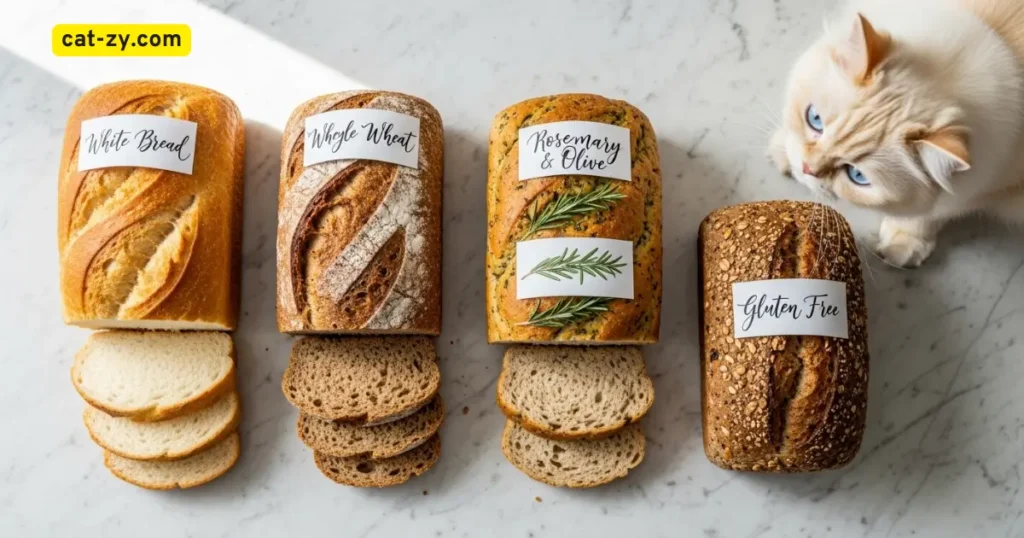
White Bread vs. Whole Wheat Bread
For those wondering, can cats eat bread? White bread and whole wheat bread differ in nutrition. White bread lacks nutrients and fiber, making it less good for cats.
Digestibility Differences
Whole wheat bread might be harder for cats to digest because of its fiber. But this difference usually doesn’t cause big problems.
Fiber Content Concerns
Whole wheat bread’s fiber can be a worry for cats. Cats don’t need much fiber. Too much can upset their stomachs.
Flavored Breads and Added Ingredients
If you’re asking, can cats eat bread? Flavored breads, like cheese or herb breads, can be risky. Cheese bread has fats and lactose, bad for cats with dairy issues.
Cheese Bread Risks
Feeding cats cheese bread can cause stomach problems. This is true for cats that can’t digest lactose well.
Fruit and Nut Breads
Breads with fruits and nuts can be dangerous. Some of these are toxic to cats. Always check the ingredients before giving bread to your cat.
Gluten-Free Bread Options
For cats with gluten issues, gluten-free bread might seem safe. But these breads often have harmful additives.
Alternative Flour Dangers
Gluten-free breads use flours from legumes or other unusual sources. These can upset a cat’s stomach.
Additives and Preservatives
Many breads, including gluten-free ones, have additives and preservatives. These chemicals can harm cats. Always check the ingredients list.
Why Do Cats Like Bread? The Science Explained
Understanding why cats like bread involves looking into their sensory preferences and instincts. Cats have unique tastes, but many owners notice their pets’ interest in bread.
The Attraction to Yeast and Fats
Bread has yeast and fats, which cats find appealing. Yeast fermentation creates compounds that give bread its smell. This smell might attract a cat’s sensitive nose.
Chemical Compounds That Attract Cats
Yeast fermentation releases chemical compounds. These include VOCs that cats find attractive because of their strong scent.
Evolutionary Factors
Some scientists think cats’ attraction to yeast is linked to their evolution. Cats are natural hunters, and their sense of smell is key. The smell of yeast might remind them of prey or food.
Texture and Smell Factors
The texture and smell of bread also attract cats. The soft texture of fresh bread is appealing. The aroma can spark their curiosity.
Sensory Processing in Felines
Cats process sensory information differently. Their brains are set up to respond to certain textures and smells. This explains why they might find bread interesting.
Bread-Seeking Behavior Patterns
Watching cats around bread shows interesting patterns. Some cats are drawn to the smell. Others are attracted to the sound of wrapping or the sight of bread being prepared.
Potential Health Risks of Feeding Bread to Cats
Feeding bread to your cat might seem safe, but it can cause health problems. It’s important to know the risks before sharing your bread.
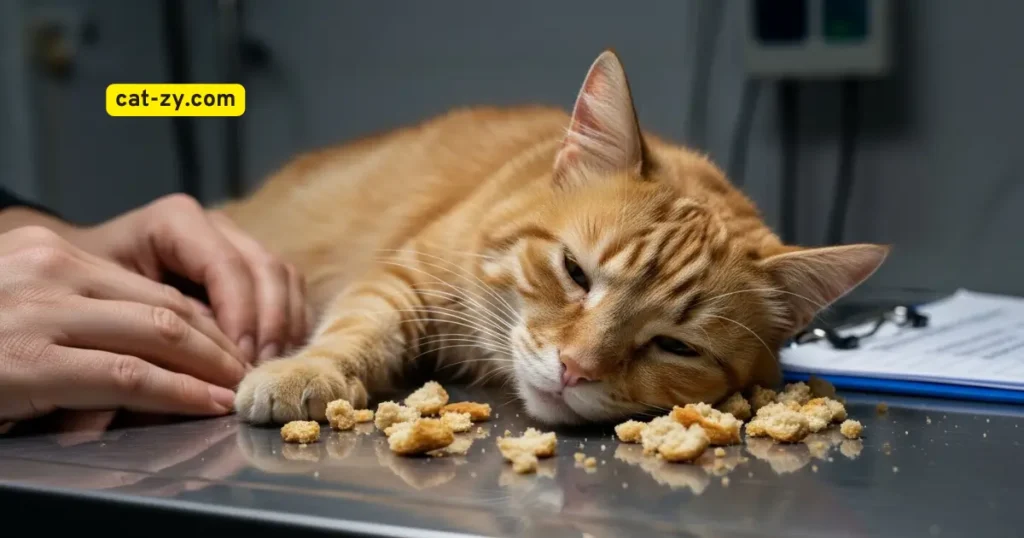
Short-term Risks: Digestive Issues
Feeding bread to cats can lead to digestive problems. Cats are meant to eat meat, not carbs like bread.
Vomiting and Diarrhea
Cats may vomit or have diarrhea from eating bread. This can cause dehydration if not treated quickly.
Intestinal Blockages
Bread can sometimes block a cat’s intestines. This is serious and needs vet help right away.
Long-term Risks: Weight Gain and Obesity
Feeding bread to cats regularly can make them gain weight. Bread has lots of calories but not much nutrition.
Caloric Density of Bread
Bread has a lot of calories. Eating it often can make a cat gain weight.
Obesity-Related Health Problems
Being overweight can lead to serious health issues in cats. These include diabetes, arthritis, and heart disease. Keeping your cat at a healthy weight is key.
Allergic Reactions to Watch For
Some cats may be allergic to bread. This can cause different symptoms.
Skin and Coat Symptoms
Allergies can cause problems with a cat’s skin and coat. This includes itching, redness, and excessive shedding.
Respiratory Concerns
Severe allergies can affect a cat’s breathing. This can cause wheezing and trouble breathing. If you see these signs, get vet help fast.
Can Kittens Eat Bread? Special Considerations
If you own a cat, you might wonder if Can cats eat bread, especially if kittens can eat bread. Kittens need special food because their bodies are growing and their digestive systems are developing. It’s important to think carefully about what they eat.
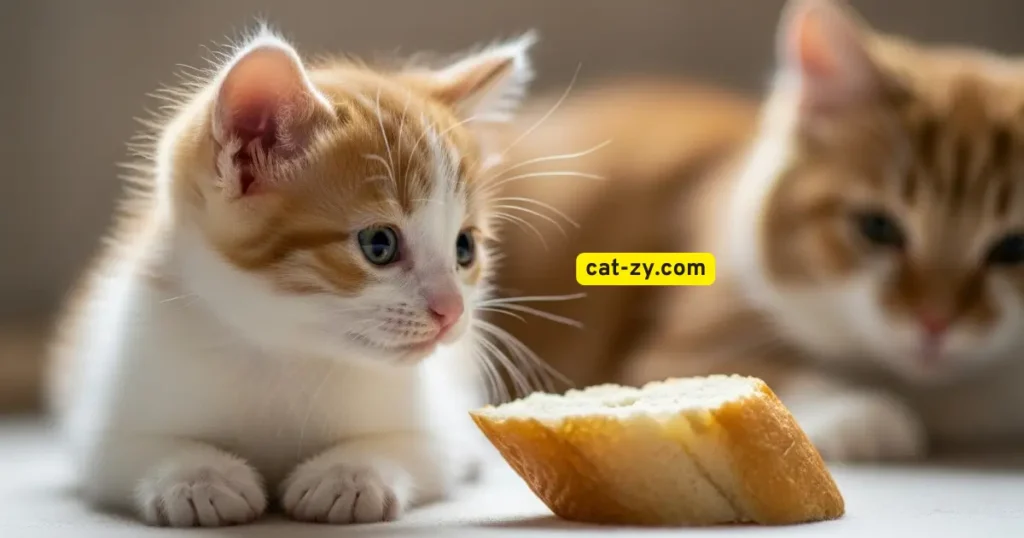
Kitten Digestive Systems vs. Adult Cats
Kittens’ digestive systems are not fully grown. This means they can’t process foods like adult cats do. Kittens have different needs and can be more sensitive to certain foods.
Developmental Stages of Digestion
Kittens go through big changes as they grow. These changes affect how they digest food. Their ability to digest certain foods changes over time.
Enzyme Production Limitations
Kittens can’t make as many enzymes as adult cats. Enzymes help break down food, like the carbs in bread. This is important when thinking about what they eat.
Nutritional Needs During Growth Stages
Kittens need a lot of protein to grow fast. A diet without enough protein can harm their health for a long time.
Critical Protein Requirements
Protein is key for kittens. It helps build their muscles, bones, and other tissues. Without enough protein, kittens can have growth problems.
Why Fillers Are Particularly Harmful
Fillers in food, like in some bread, don’t give kittens any good nutrients. They can cause stomach problems and make their diet less healthy.
In short, bread might not be the best choice for kittens. It’s better to give them a balanced diet. Talking to a vet can help find the right food for your kitten.
Signs Your Cat Has Eaten Too Much Bread
As a cat owner, I ask, can cats eat bread? It’s key to knowing when your cat has eaten too much bread. An occasional crumb is usually okay. But eating too much bread can cause health problems.
Digestive Symptoms to Watch For
When considering whether can cats eat bread, and if your cat eats too much bread, they might show signs of digestive trouble. Look out for immediate reactions like vomiting or diarrhea.
Immediate Reactions
If your cat eats a lot of bread, they might show signs like gastrointestinal upset. This can include vomiting or diarrhea a few hours later.
Delayed Symptoms
Sometimes, symptoms can show up later. Your cat might seem tired or not want to eat. Watch their behavior and health closely.
When to Contact Your Veterinarian
Knowing when to get help is important. If you see emergency warning signs, like severe vomiting or lethargy, call your vet right away.
Emergency Warning Signs
Look out for signs like trouble breathing or a fast heartbeat. These need vet help fast.
Monitoring Recovery at Home
If your cat has mild symptoms, watch them at home. Give them lots of water and a simple diet for a few days. But if their symptoms get worse, see your vet.
Healthy Alternatives to Bread for Cats
Instead of asking Can cats eat bread, look for better snacks for your cat. There are many options other than bread. Bread isn’t the best choice for cats. Luckily, there are safe and healthy treats that offer better nutrition.
Cat-Safe Treats and Snacks
Selecting appropriate treats for your feline companion is essential. They should be tasty, safe, and healthy. Here are some good choices:
Commercial Options
Many commercial cat treats are made to meet cats’ needs. Look for ones with lots of protein and few carbs. Brands like Wellness and Taste of the Wild have healthy, grain-free options.
Protein-Based Alternatives
Cats love a diet rich in protein. Try giving them freeze-dried chicken or salmon-based treats. They’re tasty and packed with protein.
Homemade Cat Treat Recipes
Want to control what’s in your cat’s treats? Making your own is a great idea. Here are some easy recipes:
Simple Meat Treats
Make healthy treats by baking or dehydrating chicken or turkey slices. This way, you avoid additives and preservatives.
Catnip-Infused Options
Cats love catnip, and you can add it to treats. Mix dried catnip with a dough of flour, eggs, and water. Then, bake into fun shapes.
Choosing healthier snacks can make your cat’s snacking time better. Always talk to your vet before changing your cat’s diet.
What Veterinarians Say About Feeding Cats Bread
When asking Can cats eat bread, veterinarians offer important advice on feeding bread to cats. As a cat owner, asking if ‘Can cats eat bread?’, you might wonder if bread is safe for your pet.
Expert Opinions and Research
Vets have studied cat diets, including human foods like bread. Veterinary nutritionists say cats need specific foods that bread doesn’t provide.
Veterinary Nutritionist Perspectives
Cats need a diet rich in animal protein, not carbs. Bread doesn’t meet these needs.
Recent Studies on Feline Diets
Studies show feeding cats human foods, like bread, can be risky. Risks include nutritional problems and allergies.
Recommended Guidelines for Occasional Treats
If you want to give your cat bread, follow some guidelines. This can help avoid harm.
The 10% Treat Rule
Treats, including bread, should not make up more than 10% of your cat’s daily calories. This prevents diet imbalances and obesity.
Monitoring Your Cat’s Overall Diet
Keep an eye on your cat’s diet and health when introducing new foods. Look out for signs of upset stomach or allergies.
By listening to vet advice and following guidelines, you can safely treat your cat with bread. Always choose a balanced diet that meets your cat’s needs.
Conclusion: Making Informed Decisions About Your Cat’s Diet
As a cat owner, knowing what to feed your pet is key to their health. The question ‘Can cats eat bread’ has been thoroughly researched and looked into. It shows that while bread is not harmful, it’s not good for their diet either.
Feeding bread to cats can cause health problems like digestive issues, weight gain, and allergies. Kittens need different food from adult cats, and bread is bad for them. So, can cats have bread? Small amounts sometimes are okay, but it’s not good for their diet. Can kittens eat bread? It’s best to avoid it because of their sensitive stomachs and special needs.
By choosing better food and knowing the risks of bread, you can keep your cat healthy and happy. Always talk to your vet for advice on what to feed your cat.
FAQ
Can cats eat bread?
Plain bread is not harmful to cats. But it’s not good for their health if they eat it too often.
Is bread safe for kittens to eat?
Kittens need different food from adult cats. Their stomachs are also more sensitive. It’s best to keep bread away from kittens.
Why do cats like bread?
Cats might like the yeast, fats, texture, and smell of bread. Each cat is different, so their reasons can vary.
Can cats have wheat bread?
Wheat bread is not toxic to cats. But it’s full of carbs and lacks nutrients. Some cats might also have wheat allergies.
What are the risks of feeding cats bread?
Bread can cause stomach problems, weight gain, and obesity in cats. It can also trigger allergies. Garlic bread and xylitol-containing bread are very dangerous.
Are there healthier alternatives to bread for cats?
Yes, there are safe treats and snacks for cats. You can find protein-based options or make your own using meat or catnip.
Can cats eat gluten-free bread?
Gluten-free bread might be better for cats with gluten intolerance. But always check the ingredients for other harmful substances or allergens.
How much bread is too much for a cat?
The right amount of bread for a cat depends on their size, age, and health. Treats should not be more than 10% of their daily calories.
What should I do if my cat eats too much bread?
Watch your cat closely if they eat too much bread. If they show signs of illness or distress, call your vet.

